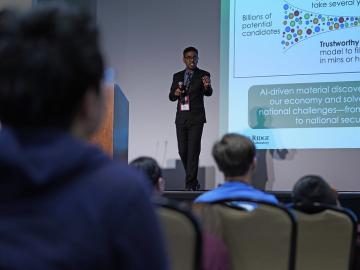
Filter News
Area of Research
- Advanced Manufacturing (2)
- Biology and Environment (35)
- Clean Energy (43)
- Computational Biology (1)
- Computational Engineering (1)
- Computer Science (5)
- Fusion and Fission (14)
- Fusion Energy (1)
- Isotopes (1)
- Materials (38)
- Materials for Computing (7)
- National Security (26)
- Neutron Science (18)
- Nuclear Science and Technology (7)
- Quantum information Science (2)
- Supercomputing (90)
News Type
News Topics
- (-) Advanced Reactors (18)
- (-) Artificial Intelligence (79)
- (-) Clean Water (16)
- (-) Composites (18)
- (-) Computer Science (145)
- (-) ITER (4)
- (-) Partnerships (48)
- 3-D Printing/Advanced Manufacturing (85)
- Big Data (34)
- Bioenergy (74)
- Biology (81)
- Biomedical (46)
- Biotechnology (19)
- Buildings (33)
- Chemical Sciences (55)
- Climate Change (72)
- Coronavirus (34)
- Critical Materials (15)
- Cybersecurity (31)
- Decarbonization (65)
- Education (4)
- Element Discovery (1)
- Emergency (2)
- Energy Storage (71)
- Environment (139)
- Exascale Computing (36)
- Fossil Energy (5)
- Frontier (40)
- Fusion (44)
- Grid (40)
- High-Performance Computing (73)
- Hydropower (5)
- Isotopes (46)
- Machine Learning (35)
- Materials (100)
- Materials Science (96)
- Mathematics (7)
- Mercury (9)
- Microelectronics (3)
- Microscopy (36)
- Molten Salt (3)
- Nanotechnology (42)
- National Security (59)
- Net Zero (11)
- Neutron Science (97)
- Nuclear Energy (82)
- Physics (54)
- Polymers (20)
- Quantum Computing (30)
- Quantum Science (56)
- Renewable Energy (2)
- Security (22)
- Simulation (40)
- Software (1)
- Space Exploration (15)
- Statistics (2)
- Summit (52)
- Sustainable Energy (77)
- Transformational Challenge Reactor (7)
- Transportation (52)
Media Contacts

Brittany Rodriguez never imagined she would pursue a science career at a Department of Energy national laboratory. However, after some encouraging words from her mother, input from key mentors at the University of Texas Rio Grande Valley, or UTRGV, and a lot of hard work, Rodriguez landed at DOE’s Manufacturing Demonstration Facility, or MDF, at Oak Ridge National Laboratory.

Researchers conduct largest, most accurate molecular dynamics simulations to date of two million correlated electrons using Frontier, the world’s fastest supercomputer. The simulation, which exceed an exaflop using full double precision, is 1,000 times greater in size and speed than any quantum chemistry simulation of it's kind.

To better predict long-term flooding risk, scientists at the Department of Energy’s Oak Ridge National Laboratory developed a 3D modeling framework that captures the complex dynamics of water as it flows across the landscape. The framework seeks to provide valuable insights into which communities are most vulnerable as the climate changes, and was developed for a project that’s assessing climate risk and mitigation pathways for an urban area along the Southeast Texas coast.

In the wet, muddy places where America’s rivers and lands meet the sea, scientists from the Department of Energy’s Oak Ridge National Laboratory are unearthing clues to better understand how these vital landscapes are evolving under climate change.

Advanced materials research to enable energy-efficient, cost-competitive and environmentally friendly technologies for the United States and Japan is the goal of a memorandum of understanding, or MOU, between the Department of Energy’s Oak Ridge National Laboratory and Japan’s National Institute of Materials Science.

Researchers used quantum simulations to obtain new insights into the nature of neutrinos — the mysterious subatomic particles that abound throughout the universe — and their role in the deaths of massive stars.

In May, the Department of Energy’s Oak Ridge and Brookhaven national laboratories co-hosted the 15th annual International Particle Accelerator Conference, or IPAC, at the Music City Center in Nashville, Tennessee.

Six firms received Small Business Awards from the Department of Energy’s Oak Ridge National Laboratory. The companies, selected from small business service providers to the lab, were recognized by ORNL's Small Business Programs Office for their specific capabilities and contributions.

Researchers at ORNL and the University of Maine have designed and 3D-printed a single-piece, recyclable natural-material floor panel tested to be strong enough to replace construction materials like steel.

Prasanna Balaprakash, a national leader in artificial intelligence, or AI, spoke to some of the highest achieving students in the country at the National Science Bowl in Washington D.C.


